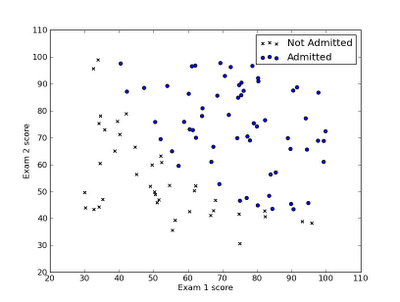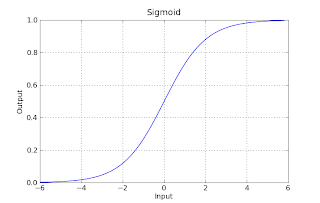逻辑回归和线性回归的差异就是预测模型h的输出,前者输出0和1两个离散值,而线性回归输出连续值。在为分类预测建立模型时候,显然线性回归学习就不是很适合,要用逻辑回归学习算法。例如将下面数据分类:

先看看逻辑回归的预测模型吧:

x是预测对象的features。g(x)函数是大名鼎鼎的S型函数(sigmoid function):

看图直观感受一下这个函数:

从图就可以看书,g(z)的值大部分都在0和1附近,这就是为什么我们的预测模型h(x)可以很适合输出离散值去预测分类问题了。
好了,模型有了,下面的主要任务就是确定模型中theta的值,这就是学习算法的主要任务。
同线性回归一样,需要设计一个代价函数(cost function),然后需要计算每个theta对应的梯度(gradient)
代价函数这样设计:

然后求theta变量的梯度,如果你的高数学的比较好,你可以自己推导求出梯度gradient,对照是不是下面这个结果:

现在问题来了,为什么要求梯度?
在线性回归中我们了解到,求出梯度后利用梯度做“梯度下降”算法,更新theta值,最终优化代价函数J(theta),使J(theta)的值最小。
在这儿求梯度也是同样的道理。
Python中的scipy模块中的fmin_bfgs函数可以优化J(theta)是其最小,我们只要把J(theta)函数和梯度gradient最为参数传给fmin_bfgs这个函数就行了。
优化完毕后,得到theta值。
有了theta值,我们就可以预测新的数据X了,就是theta和X代入模型,小学生都会。
theta*X=0就是决策边界(decision boundary),画出来看一看更直观:

具体实现细节看下面代码:(代码中用到的数据“ex2data1.txt"可以在这里下载)
__author__ = 'jianyong'
# machine learning -- logistic regression by python
import numpy as np
import pylab as pl
# load and visit data
data=np.loadtxt('ex2data1.txt',delimiter=',')
X=data[:,0:2]
y=data[:,2]
pos=np.where(y==1)
neg=np.where(y==0)
pl.scatter(X[pos,0],X[pos,1],marker='o',c='b')
pl.scatter(X[neg,0],X[neg,1],marker='x',c='r')
pl.xlabel('exam1 score')
pl.ylabel('exam2 score')
pl.legend(['admitted','not admitted'])
pl.show()
# sigmoid function cost function and gradient function
def sigmoid(x):
return 1/(1+np.exp(-x))
def cost(theta,X,y):
h=sigmoid(np.dot(X,theta))
l=(-y)*np.log(h)-(1-y)*np.log(1-h)
return np.mean(l)
def gradient(theta,X,y):
h=sigmoid(np.dot(X,theta))
error=h-y
grad=np.dot(error,X)/np.size(y)
return grad
# since we have cost and gradient now ,we can optimize the theta
import scipy.optimize as opt
theta=0.1*np.random.randn(3) # this example have 2 feature:x1 and x2,so need three theta
X_append=np.append(np.ones((X.shape[0],1)),X,axis=1)
theta_optimize=opt.fmin_bfgs(cost,theta,fprime=gradient,args=(X_append,y))
# now we get the optimized theta ,so we can use this theta_optimize to predict new x
def predict(theta,X):
h=sigmoid(np.dot(X,theta))
return h>0.5
# we can plot the data with decision boundary
def plotDataWithBoundary(X,theta):
x1=np.array((min(X[:,1]),max(X[:,1]))) # two point's x1 value
x2=-(theta[1]*x1+theta[0])/theta[2] # two point's x2 value
pl.scatter(X[pos,1],X[pos,2],marker='o',c='b')
pl.scatter(X[neg,1],X[neg,2],marker='x',c='r')
pl.plot(x1,x2)
pl.xlabel('exam1 score')
pl.ylabel('exam2 scroe')
pl.legend(['admitted','not admitted','decision boundary'])
pl.show()
plotDataWithBoundary(X_append,theta_optimize)




























 1357
1357

 被折叠的 条评论
为什么被折叠?
被折叠的 条评论
为什么被折叠?








